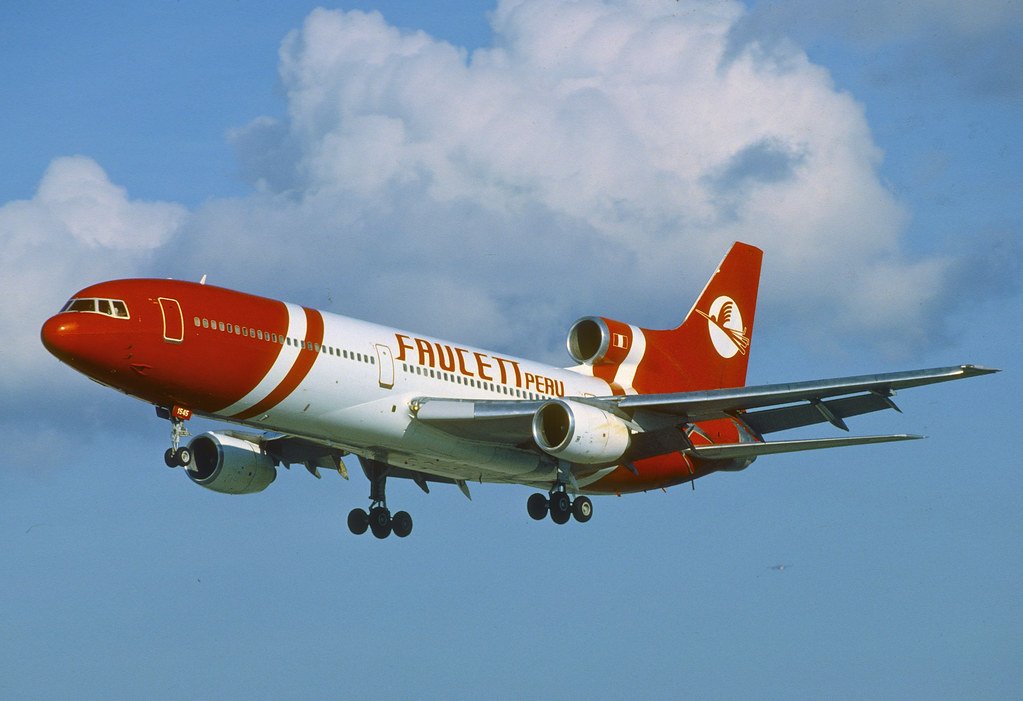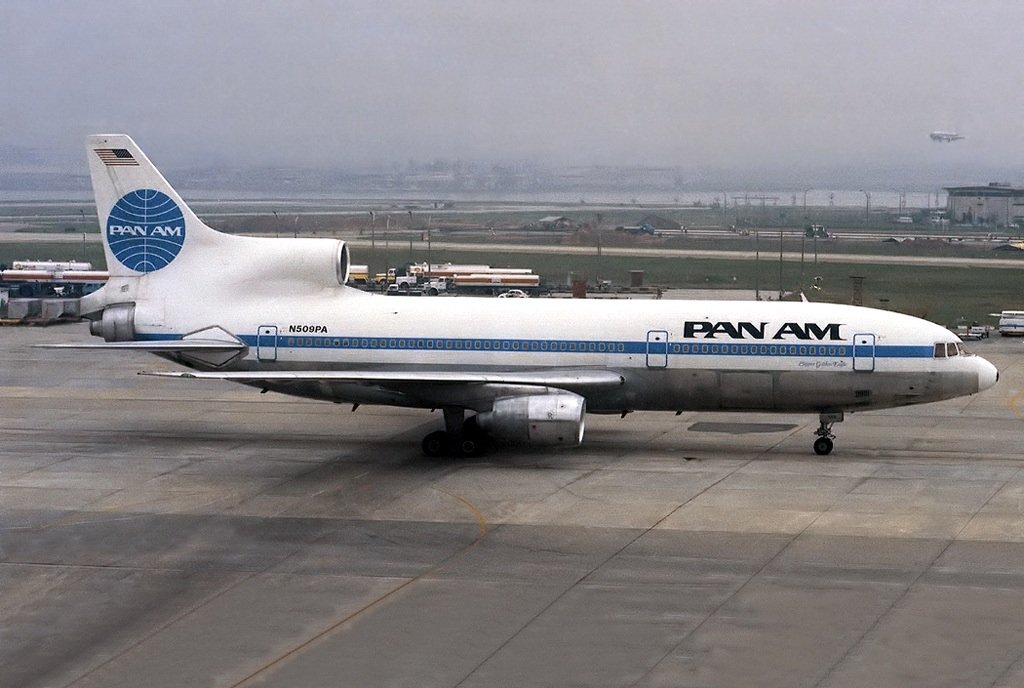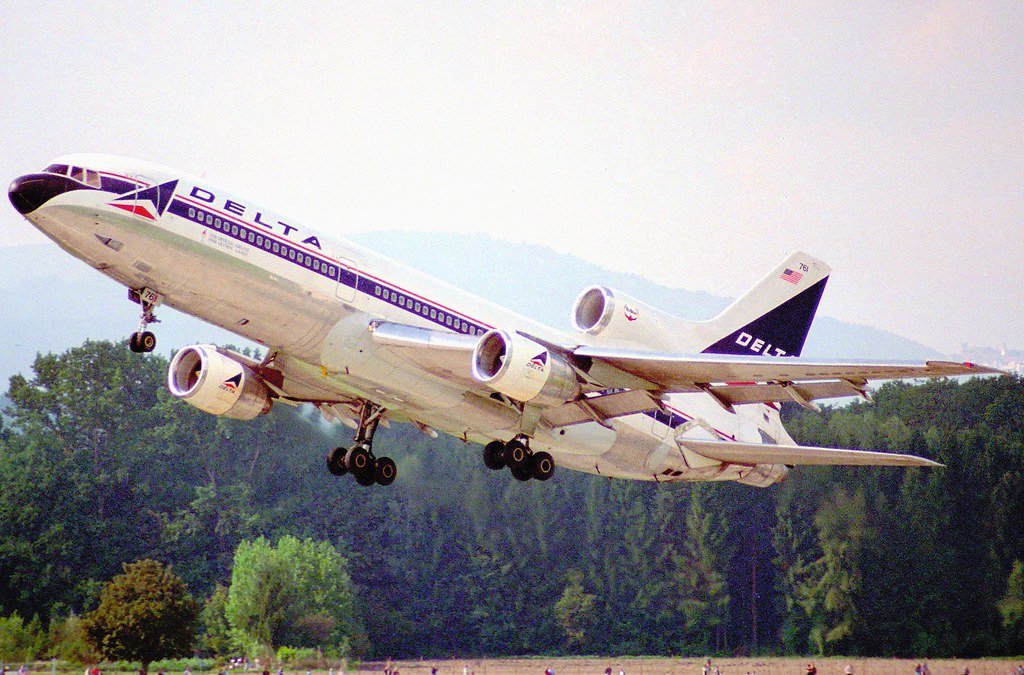
Lockheed L1011 Tristar.
SPECS
HISTORY
Pan Am Lockheed L-1011-500 Tristar, registration N509PA named Clipper Golden Eagle.
The Lockheed Tristar, also known by its designation L1011(ell-ten-eleven), is to date the only commercial jet transport produced by the Lockheed Corporation. The name Tristar was decided upon after a staff competition.
Known for their successes with military transports such as the C141 Starlifter and the C5 Galaxy, the company had not produced a commercial passenger transport since the four-engined turboprop L188 Electra.
This aircraft ceased production in 1961. The Electra incidentally went on to become the basis for the C130 Hercules military transport.
BWIA International Lockheed L1011 Tristar registration 9T-TGJ. Here we get a good view of the rear engine arrangement with the intake above the fuselage and the exhaust in the tail cone.
It seems that other than a few differences, the Lockheed L1011 Tristar and the McDonnell Douglas DC 10 were very similar aircraft.
To look at it, the main difference was in the configuration of the Number 2 engine, the one located at the rear of the fuselage. Where McDonnell Douglas had mounted their engine above the fuselage as part of the tail, Lockheed opted for an internal fuselage mount.
The Lockheed system was very similar to the Boeing 727. This consisted of the engine being housed inside the tail cone of the fuselage and the air intake consisting of an S bend, bringing air from the top of the fuselage down into the engine. The curves of the S bend were gentle enough so as not to impede airflow. Any loss of performance from this arrangement was offset by the lack of weight penalties associated with external mounts and nacelles.
Eastern Lockheed L1011 Whisperliner registration N306EA 1973 Miami.
There was, however, quite a different approach in the ways the two manufacturers addressed the challenge.
For their part, McDonnell Douglas was heavily constrained by budget. As a result, they borrowed heavily from the technology of their DC 8 jet airliner.
Lockheed on the other hand, and maybe this is because they didn't have a legacy passenger transport to borrow from, used new technology where ever possible and where it didn't exist they created it. The engine technology that Lockheed called for made for a quieter aircraft. So noticeable that Eastern Air Lines dubbed their L1011s, WhisperLiners.
SPECIFICATIONS
Some of the new technologies which were differentiators introduced by Lockheed were:
Advanced Auto-Pilot. The advanced auto-pilot was rated for Cat-IIIc auto landing. In other words, the L1011 was capable of landing in zero visibility conditions using the auto-pilot.
Direct Lift Control(DLC). The DLC system enabled much smoother landing approaches. Rather than large changes in pitch as the aircraft went through various stages of the approach, the wing slats were automatically deployed and adjusted to achieve the same result. This enabled a more stable pitch throughout the landing phase.
Auto Clave. Auto Clave was a system for bonding fuselage panels that made them very resistant to corrosion.
Saudia, Saudi Arabian Airlines was the launch customer for the Lockheed Tristar L1011-200. The 200 was a popular choice for airlines such as Saudia and Cathay Pacific due to its longer range. By moving the galley from the cargo hold level to the main passenger deck, Lockheed created more space below. This enabled an additional fuel tank to be located in the centre section.
Lockheed L1011 Tristar Specs Table
| L1011-1 | L1011-200 | L-1011-500 | |
|---|---|---|---|
| Flight Crew | 3 | ||
| Prices | US$20M (1972) | - | US$200M (today) |
| Milestones | |||
| Maiden Flight | 16 NOV 1970 | Late 1976 | 16 OCT 1978 |
| Launch Delivery | 26 APR 1972 | 28 MAY 1977 | 27 APR 1979 |
| Launch Airline | Eastern Air Lines | Saudi Arabian Airlines | British Airways |
| Final Delivery | 07 MAR 1983 | 04 NOV 1981 | 03 OCT 1983 |
| Total Produced (Total 251) | 157 | 44 | 50 |
| Power Plant | |||
| Manufacturer | Rolls Royce | ||
| Type | RB211-22 | RB211-524B | |
| Thrust | 187Kn (42,000lbf) | 222Kn (50,000lbf) | |
| Dimensions | |||
| Fuselage | |||
| Aircraft Length | 54.17M (177Ft 8.5In) | 50.05M (164Ft 2.5In) | |
| Height | 16.87M (55Ft 4In) | ||
| Fuselage Width (Outside) | 5.97M (19Ft 7In) | ||
| Cabin Width (Interior) | 5.77M (18Ft 11In) | ||
| Wing | |||
| Span | 47.35M (155Ft 4In) | 50.09M (164Ft 4In) | |
| Wing Area | 321.1M2 (3,456Ft2) | 329.0M2 (3,541Ft2) | |
| L1011-1 | L1011-200 | L-1011-500 | |
| Under carriage | |||
| Number of Nose wheels | 2 | ||
| Number of Main wheels | 8 (2x4) | ||
| Cabin | |||
| Typical Seating (mixed class) | 256 | 246 | |
| Exit Limit | 400 | 330 | |
| Seats Abreast (typical) | First Class 6 (2-2-2) Economy Class 8 (2-4-2) | ||
| Weights | |||
| Max. Takeoff Weight(MTOW) | 200,000Kg (430,000lb) | 211,374Kg (466,000lb) | 231,332Kg (510,000lb) |
| Operating Empty Weight (OEW) |
110,000Kg (241,700lb) | 113,000Kg (248,400lb) | 111,000Kg (245,400lb) |
| Fuel | |||
| Fuel Capacity | 90,150L (23,814 US Gal) | 100,320L (26,502 US Gal) | 119,780L (31,642 US Gal) |
| Speeds | |||
| Mmo Mach Maximum Operating speed |
Mach 0.90 / 516Kn / 956 Kph | ||
| Cruise Speed Knots/Kph | 520Kn (963Kph) | 515Kn (954Kph) | 525Kn (972Kph) |
| Stall Speed | 108Kn (200Kph) | 110Kn (204Kph) | 114Kn (211Kph) |
| Ceiling (Ft) | 12,800M (42,000Ft) | 13,100M (43,000Ft) | |
| Range | 4,250NM (7,871Km) | 4,935NM (9,140Km) | 6,090NM (11,279IKm) |
| L1011-1 | L1011-200 | L-1011-500 | |
In the late 1960s, American Airlines approached aircraft manufacturers, Douglas and Lockheed. They were looking for a new widebody jet, smaller than the Boeing 747, but still capable of flying intercontinental routes.
Rising to the challenge, the original Lockheed design was for a giant twin-engined aircraft. However, the ETOPS30 (Extended Operations) restriction determined that these twin aircraft could fly no more than 30 minutes from the nearest available airfield.
This made international operations impossible, therefore, a three-engined design was settled upon that avoided that restriction. The three-engine design also enabled the jet to use existing runways due to the higher take-off performance.
History.
Air Transat Lockheed L-1011 TriStar.
The adherence by Lockheed to new cutting-edge technologies for the Tristar meant that the aircraft was more expensive than its DC 10 competitor. The market reasoned that it was more expensive than the DC 10 and by spending a little more you could buy a Boeing 747.
The other factor that went against the L1011 Tristar is that Lockheed insisted on one engine choice only. The Rolls Royce RB211. Where McDonnell Douglas was much more flexible with engine options for the DC 10, Lockheed maintained its cutting-edge technology approach. The RB211 concept was certainly superior to other options available at the time, however, it came at a high cost. Rolls Royce went into receivership through the high development cost.
It was only the British government coming in with heavy subsidies that allowed it to continue the development to fruition. The British government required the U.S. government to guarantee any loans required by Lockheed to complete the L1011 project, to ensure their funding of Rolls Royce was not for nothing. Rolls Royce was run very much like a government department from this point on. This ensured the project for the RB211 was completed but hampered any extra development. This meant that the development of the more powerful RB211-524 came to market many years later and was certainly behind General Electric with their CF6.
Trans World Airlines TWA Lockheed L-1011-385 TriStar.
These hold-ups meant that sales were delayed two years. Lockheed failed to secure American Airlines as a launch customer, that airline opting for the DC 10. One could be forgiven for thinking that American Airlines used Lockheed to try and drive the price down on the DC 10.
With its maiden flight on 16 November 1970, the Tristar gained F.A.A. certification on 14 April 1972 and was delivered to Eastern Air Lines on 26 April 1972.
In 1972 the L1011 Tristar was taken on tour with famed Lockheed test pilot Tony LeVier in command. The tour included a "groundbreaking event" using the advanced autopilot where the aircraft flew from Palmdale to Dulles in 4 hours and 13 minutes. The groundbreaking part was that it was totally under autopilot control from take-off roll to landing. No human hands touched the controls.
Delta Air Lines Lockheed L-1011 TriStar 500 registration N761DA at Zurich (ZRH).
Lockheed produced the L1011 in two fuselage lengths at their Palmdale, California plant just north of Los Angeles. These were the L1011-1 and the L-1011-500. When finally the Rolls Royce RB211-524 engine became available, Lockheed offered the L1011-1 at high gross weights. Upgrade kits were also made available to existing L1011-1s.
Produced between 1968 to 1984, Lockheed manufactured 250 Tristars. This was out of an expected 500 which they required to break even. Perhaps this can be seen as a classic case study of too small a market for the offering. Lockheed after the wrap-up of the Tristar bowed out of the commercial aviation market. McDonnell Douglas, whilst meeting their target with the DC 10, failed to follow up with their MD-11 and was merged with Boeing.
LTU Lockheed L1011 Tristar.
Both competitors had setbacks. Lockheed with the Rolls Royce delay and McDonnell Douglas with major safety concerns. Perhaps that assisted in keeping it a comparatively even playing field.












